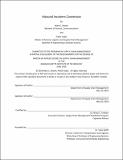Inbound Incoterm Conversion
Author(s)
Brown, Mark; Yadav, Pratik
DownloadBrown_Yadav_2019.pdf (2.360Mb)
Metadata
Show full item recordAbstract
Most organizations spend significant time on improving the processes and systems related to outbound movement of goods, i.e., cargo moving from the production site to customers. This focus often ignores the other aspect of the supply chain, namely inbound cargo movement, which refers to the shipments coming from the suppliers to either the purchasing organization or the production site of the organization. This capstone project investigates the various material buying arrangements (which primarily differ in operational setup and risk) that the buying entity will take on. This capstone project focuses on a selected group of twelve products from two suppliers with different characteristics such as origin, volume, price, supplier relationship, etc. Total logistics costs including the transport cost, purchase cost, and inventory costs are calculated. Risk is also included per incoterm option to give an overview for business managers on how to approach the buying decisions. In general, if the company would like to convert from C&D to E&F incoterms, it would mean that the buying organization is taking more risk upon itself and hence needs to have a solid operational setup (inhouse or outsourced) to manage the ownership responsibilities that come with changing incoterms. The end result is a matrix of selected scenarios which will allow the buyer to understand the risk associated with each incoterm under a set of conditions and the expected cost difference. The section ends up with opportunities that might be presented if the organization starts buying more under E&F incoterms instead of C&D incoterms along with the potential risk rating under each scenario.
Date issued
2019Keywords
Risk Management, Product Development, Strategy